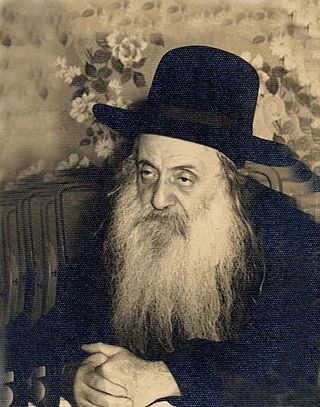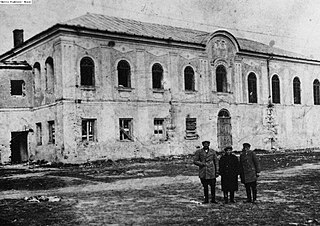Zychlin (Hebrew: זיכלין) is a Hasidic dynasty originating from the town of Żychlin, Poland, where it was founded by Shmuel Abba Zychlinski (1809–1879). [1] Zychlin is a branch of Peshischa Hasidism, as Shmuel Abba Zychlinski was a leading disciple of Simcha Bunim of Peshischa (1765-1827).
The first Rebbe of Zychlin, Rabbi Shmuel Abba, taught that one needs to not only repent but repent through the learning of Jewish holy subjects. [2] Reb Zelig was a relative of the Sabba Kadisha of Strikov, Reb Fishel, going to visit him and taking his young son Shmuel Abba with him. Rabbi Shmuel Abba was known as the Ilui ("genius") of Luvitch and many scholars praised his depth and understanding. When Rabbi Shmuel Abba was older he learned at the Peshischa yeshiva which was led at that time by Rabbi Simcha Bunim of Peshischa. He considered himself one of Rabbi Simcha Bunim's disciples.
Rabbi Shmuel Abba had a small following of Hasidim and lived at his father-in-law's house, but when he moved to Zychlin for monetary reasons he acquired a larger following. Shmuel Abba was known as a miracle worker. Shmuel Abba spent time in jail because his detractors were upset that he practiced practical Kabbalah.
Ninety-five percent of Zychliner Hasidim perished during the Holocaust, the last Rebbes dying at the hands of the Nazis.
Ger is a Polish Hasidic dynasty originating from the town of Góra Kalwaria, Poland, where it was founded by Yitzchak Meir Alter (1798–1866), known as the "Chiddushei HaRim". Ger is a branch of Peshischa Hasidism, as Yitzchak Meir Alter was a leading disciple of Simcha Bunim of Peshischa (1765–1827). Before the Holocaust, followers of Ger were estimated to number in excess of 100,000, making it the largest and most influential Hasidic group in Poland. Today, the movement is based in Jerusalem, and its membership is estimated at 11,859 families, as of 2016, most of whom live in Israel, making Ger the largest Hasidic dynasty in Israel. However, there are also well-established Ger communities in the United States and in Europe. In 2019, some 300 families of followers led by Shaul Alter, split off from the dynasty led by his cousin Yaakov Aryeh Alter.

Vizhnitz is the name of a Hasidic dynasty founded by Rabbi Menachem Mendel Hager. Vizhnitz is the Yiddish name of Vyzhnytsia, a town in present-day Ukraine.

Yitzchak Meir Rotenberg-Alter , was the first Rebbe of the Ger Hasidic dynasty, which he founded in the town of Góra Kalwaria, Poland. He headed the Kupath Rabbi Meir Baal Haness Kollel Polen (Poland) Varsha (Warsaw). He was also known as The Chiddushei HaRim for his Torah writings, and was sometimes fondly called Reb Itche Meir (Yiddish) by his followers.

Yaakov Yitzchak HaLevi Horowitz, known as "the Seer of Lublin", ha-Chozeh MiLublin; was a Hasidic rebbe from Poland.

Aleksander is a Polish Hasidic dynasty originating from the city of Aleksandrow Lodzki, Poland, where it was founded by Shraga Fayvel Dancyger. Aleksander is a branch of Vurka, as Shraga Fayvel Dancyger was a leading disciple of Rabbi Israel Yitzhak Kalish of Vurka. Prior to the Holocaust, Aleksander was the second to largest Hasidic group in Poland. They attracted artisans, merchants and water carriers rather than elite Talmudic scholars and richer people who were attracted to Ger. Like the rest of Polish Jewry, almost all of Aleksander hasidim were murdered in the Holocaust. Between the world wars, Hasidic Jews from all over flocked to the small village of Aleksander to spend the holiest days of the Jewish year in the presence of their spiritual leader, their rebbe, Rabbi Yitzchak Menachem Dancyger (1879–1942). The Rebbe of Aleksander attempted to remain neutral in political issues while emphasizing communal prayer and the study of Torah. He was murdered by the Germans on September 5, 1942, eight days before Rosh Hashana, at Treblinka extermination camp. Today, Aleksander has emerged from the ashes of the Holocaust and continues growing in numbers in small communities in America, Europe and Israel.

Simcha Bunim Bonhardt of Peshischa also known as the Rebbe Reb Bunim was the second Grand Rabbi of Peshischa as well as one of the key leaders of Hasidic Judaism in Poland. The main disciple of R. Yaakov Yitzchak Rabinowicz, from 1813 to 1827, he led the Peshischa movement of Hasidic thought, in which he revolutionized 19th-century Hasidic philosophy by juxtaposing the rationalistic pietism of German-Jewry with the spiritual nature of God defined by the Hasidic movement.

Amshinov is a Polish Hasidic dynasty originating from the town of Mszczonów, Poland, where it was founded by Yaakov Dovid Kalish, the son of Israel Yitzhak Kalish. Amshinov is a branch of Warka Hasidism, which in part is a branch of Peshischa Hasidism, as Israel Yitzhak Kalish was a leading disciple of Simcha Bunim of Peshischa (1765-1827).
Biala is a Hasidic dynasty originating from the city of Biała Rawska, where it was founded by R. Yaakov Yitzchak Rabinowicz (II). Biala is a branch of Peshischa Hasidism, as R. Yaakov Yitzchak Rabinowicz (II) was the great-grandson of R. Yaakov Yitzchak Rabinowicz, the first Peshischa Rebbe. The dynasty was originally spread throughout many towns in Poland, often taking the names of said towns. However, after the Holocaust, the name "Biala" become synonymous with the entire dynasty. Today the dynasty is mostly concentrated in Israel, America and Switzerland.
The Ozerov Hasidic dynasty is a Hasidic group that began in 1827 when Rabbi Yehudah Leib Epstein, Rabbi of Ożarów in Poland since 1811, assumed leadership of his Hasidim ("disciples"). Ozerov is known for its learning, as one of the intellectual Hasidic dynasties.

Żychlin is a town in Kutno County, Łódź Voivodeship, Poland, about 50 north of Łódź and 90 kilometres west of Warsaw. It has 7,964 inhabitants (2020).
Mordechai Yosef Leiner of Izbica known as "the Ishbitzer" (1801-1854) was a rabbinic Hasidic thinker and founder of the Izhbitza-Radzyn dynasty of Hasidic Judaism. He is best known for his work Mei Hashiloach.

Izhbitza-Radzin is the name of a dynasty of Hasidic rebbes. The first rebbe of this dynasty was Rabbi Mordechai Yosef Leiner, author of Mei Hashiloach, in the city of Izhbitza. Mordechai Yosef founded his own Hasidic movement in the year 5600 (1839), leaving the court of Rabbi Menachem Mendel of Kotzk.

Kotzk is a Hasidic dynasty originating from the city of Kock, Poland, where it was founded by Menachem Mendel Morgenstern (1787–1859). Kotzk is a branch of Peshischa Hasidism, as Menachem Mendel Morgenstern was the leading disciple of Simcha Bunim of Peshischa (1765–1827). Following Simcha Bunim's death he led the divided Peschischa community, which he eventually incorporated into his own Hasidic dynasty. Kotzk follows a Hasidic philopshy known for its critical and rationalistic approach to Hasidism and its intense approach to personal improvement which is based on a process of harsh constructive criticism and total transparency of self. Kotzk is closely connected to other branches of Peshischa Hasidism such as Ger and Aleksander and is currently based out of Jerusalem.
Yaakov Yitzchak Rabinowicz of Peshischa also known as the Yid Hakudosh or the Yehudi was the founder and first Grand Rabbi of the Peshischa movement of Hasidic philosophy, and an important figure of Polish Hasidism. The leading disciple of Yaakov Yitzchak of Lublin, the Yehudi preached an "elitist" approach to Hasidism, in which he parred traditional Talmudic learning with the highly spiritual Kavanah of Hasidism. He encouraged individuality of thought, which brought his movement into conflict with the Hasidic establishment. Nevertheless, several of his teachings would go on to influence large percentages of modern Hasidism. Following his death in 1813, he was succeeded by his main disciple Simcha Bunim of Peshischa, who increased his movement's influence tenfold. The Yehudi is the patriarch of the Porisov and Biala Hasidic dynasties.
Sochatchov is a Hasidic dynasty originating from the town of Sochaczew, Poland, where it was founded by Avrohom Bornsztain (1838–1910). Sochatchov is a branch of Kotzk Hasidism, which in part is a branch of Peshischa Hasidism. After World War I the dynasty was moved to Łódź and, subsequently, to other nearby towns. After World War II the dynasty was transplanted to Israel, where it thrives to this day.

Peshischa was an important Hasidic school of thought based out of Przysucha, Poland founded by Yaakov Yitzchak Rabinowicz, which flourished during the late 18th to early 19th century. Its teachings are the foundation for Kotzk Hasidism, Ger Hasidism, Amshinov Hasidism, Zychlin Hasidism, Aleksander Hasidism, Vurka Hasidism, Sochatchov Hasidim, Porisov Hasidim, Biala Hasidim and Izhbitza-Radzin Hasidism.
Vurke is a Hasidic dynasty originating from the city of Warka, Poland, where it was founded by Israel Yitzhak Kalish (1779–1848). Vurka is a branch of Peshischa Hasidism, as Israel Yitzhak Kalish was a leading disciple of Simcha Bunim of Peshischa (1765–1827). Following Simcha Bunim's death, he led a part of the divided Peschischa community, in Przysucha, later incorporating the community into his own Hasidic dynasty based in Warka. Like the other branches of Peshischa Hasidism, such as Kotzk and Ger, Vurka is known for their rationalistic and individualistic approach to Hasidism.
Reb Shmuel ben Avraham Yeshayahu of Karov was a late 18th-century Polish Hasidic rebbe who was a leading disciple of both Elimelech of Lizhensk and Yaakov Yitzchak of Lublin.
Hasidic Judaism in Poland is the history of Hasidic Judaism and Hasidic philosophy in Poland. Hasidic Judaism in Poland began with Elimelech Weisblum of Lizhensk (Leżajsk) (1717-1787) and to a lesser extent Shmelke Horowitz of Nikolsburg (Mikulov) (1726-1778). Both men were leading disciples of Dov Ber of Mezeritch (Medzhybizh), who in part was the successor to the Baal Shem Tov who founded Hasidic Judaism in Western Ukraine. Today, a sizable portion of contemporary Hasidic Judaism and Hasidic dynasties trace their genealogical and ideological origin to Polish Hasidism.

Grand Rabbi Moshe Biderman (1776-1851) of Lelów was the 2nd Rebbe of the Lelov Hassidic dynasty.